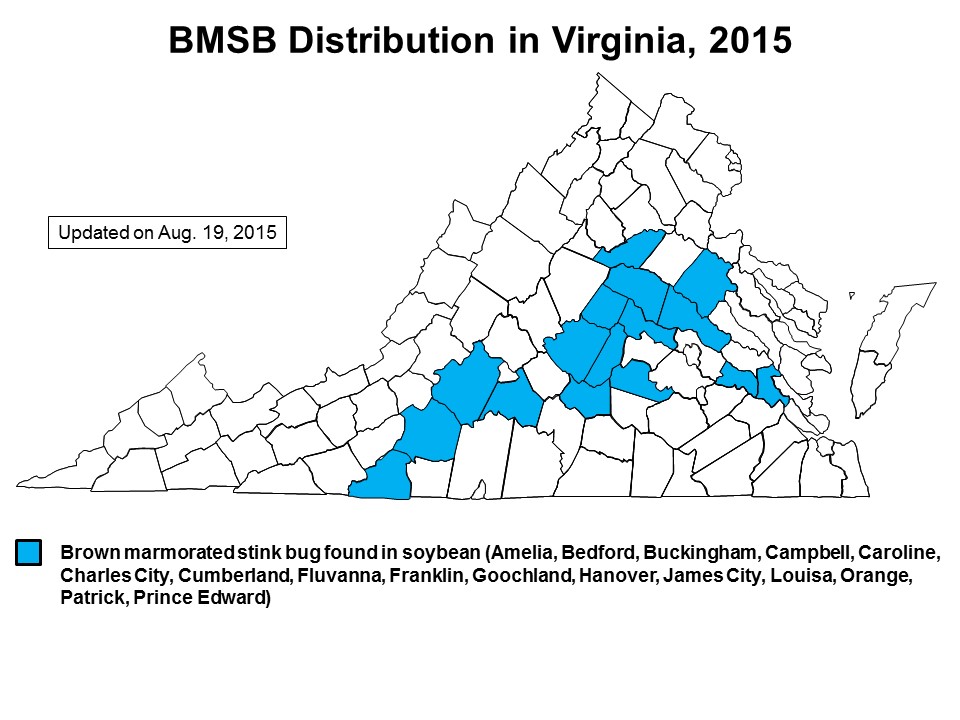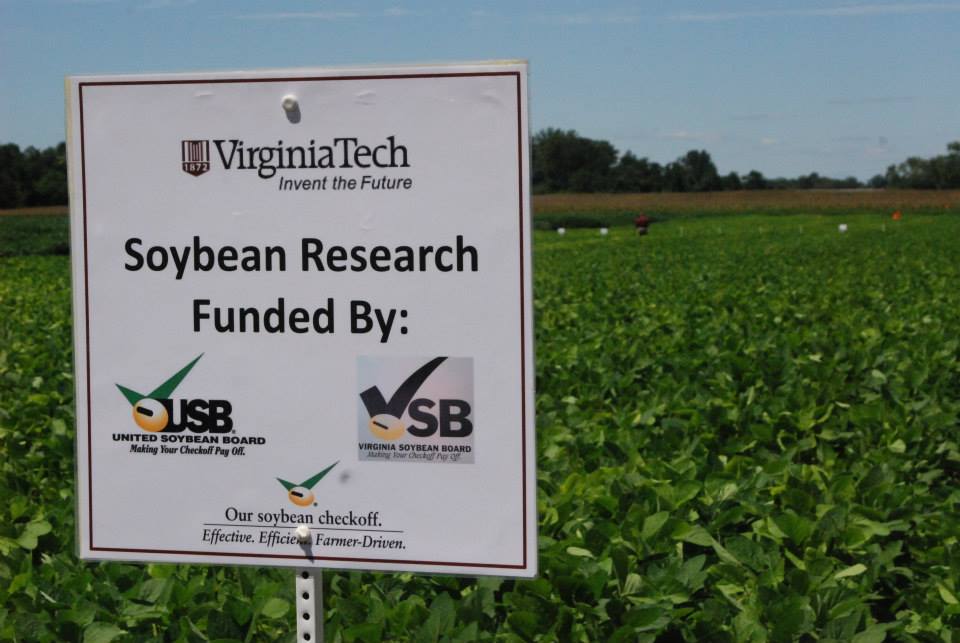Our soybean scouts have detected BMSB in a few more Virginia counties this week, all in low numbers. Please see the map for more details.
Category Archives: Insect

The Virginia Soybean Field Day is this Thursday
VIRGINIA SOYBEAN FIELD DAY
Thursday August 20, 2015
Eastern Virginia Agricultural Research & Extension Center
2229 Menokin Road
Warsaw, VA 22572
(804) 333-3485
Sponsored by
Virginia Soybean Association
Virginia Agricultural Experiment Station
Virginia Cooperative Extension
Join us to see the latest research on soybean varieties, disease and weed management, IPM and sorghum varieties. Experts will also demonstrate no-till drill maintenance and update you on the mid-Atlantic double crop initiative. Registration begins at 8:00 am and field tours begin at 8:50 am. The program will end at noon with a delicious meal by Nixon Catering.
Topics include:
– Soybean Disease Management – Dr. Hillary Mehl
– Soybean Weed Management – Dr. Mike Flessner
– Soybean Insect IPM – Mr. Mike Parish and Drs. Sean Malone and Ames Herbert
– No-Till Drill Maintenance – Mr. Keith Burgess
– Grain Sorghum Management – Dr. Joseph Oakes
– Roundup-Ready Public Soybean Varieties – Dr. Bo Zhang
– Mid-Atlantic Double-Crop Soybean Initiative – Dr. David Holshouser
We hope to see you there!
Black light trap catches for the week ending August 6, 2015
Corn earworm moth captures started increasing in area black light traps, ranging from 0.3 to 7.5 per night. Brown marmorated stink bug nightly averages ranged from zero to 12.9. Please see the data tables for specifics. Thanks to the following for their reports this week: John Allison, Scott Reiter, David Moore, Mary Beahm, Austin Brown, Janet Spencer, Keith Balderson, and Ames Herbert and his entomology crew. BLT_Aug_6
Helicoverpa zea (corn earworm/bollworm) pyrethroid resistance monitoring update for August 6, 2015
To date, we have tested 371 H. zea in adult vial tests, with a mean survival rate of 31.9% in the treated vials (5 micrograms cypermethrin). Please see the attached Figure for more details: AVT_6_Aug
Brown marmorated stink bug distribution update for August 6, 2015
Our scouts found a BMSB nymph in Franklin County soybean this past week. Populations in soybean remain low; please also see the black light trap report. Here is the map of all 3 counties where BMSB have been detected in soybean in 2015: BMSB_map_6_Aug
Kudzu bug distribution update for August 6, 2015
Kudzu bug has been found in soybean in 30 Virginia counties. Most populations were low (zero to 2 adults per 15 sweeps), although a field in Pittsylvania at R2 growth stage had an average of 13 kudzu bugs per sample. Please see the data table for recent samples (kb_data_6_Aug) and the state distribution map (KB_map_6_Aug) for more details.
Annual Corn Earworm Field Corn Survey–2015
Annually, we conduct a survey to estimate Helicoverpa zea (corn earworm) infestation levels in field corn in mid- to late July. Corn is considered a nursery crop for corn earworm, allowing the pest to complete a lifecycle and then move on to other crops such as soybean, cotton, and peanut in August. Over 30 years of data show that there is a linear correlation between the infestation level in corn and the amount of soybean acreage that gets treated with insecticide for this pest.
To conduct the survey this year, the number of corn earworm larvae found in 50 ears of corn was recorded in 5 corn fields in each of 25 counties, totaling 6,250 ears and 125 fields sampled. When fields were known to contain Bt or non-Bt corn, this was noted. Otherwise, samples were considered to be random and assumed to be representative of the actual Bt/non-Bt composition in each county. Age of corn earworms, or if they had already exited the ears, was also recorded (data not shown). We greatly appreciate the help of Virginia Cooperative Extension Agriculture and Natural Resource (ANR) Agents, Virginia Tech faculty and staff, summer agricultural assistants, and interns in this effort. These cooperators are acknowledged in the attached Figure. We also would like to thank the many growers who graciously allowed us to inspect their fields for corn earworm larvae.
Results of the survey are provided in the Figure (CEW_survey_2015). Statewide, approximately 17.5% of ears were infested with corn earworm. This is even lower than the numbers reported in 2014 (20%) and 2013 (18%)—both years with very few cotton, peanut or soybean fields being infested with treatable numbers of worms. Regional averages for 2015 were 4% infested ears in the Northern Neck, 13.4% in Mid-Eastern, 9.5% in South-Central, and 27.7% in the Southeast.
So far, all indicators point to another year with few fields reaching thresholds. We will continue monitoring and posting updates.
This survey is intended to be a representative sample, not a complete picture. We always recommend scouting individual fields to determine exactly what is happening in terms of corn earworm as well as other pests and crop problems. Also, please check the black light trap reports on the Virginia Ag Pest and Crop Advisory and other reports posted weekly to keep up-to-date on the insect pest situation.
Black light trap catches for the week ending July 30, 2015
Corn earworm moth captures ranged from zero to 2.3 per night in area black light traps; brown marmorated stink bug nightly averages ranged from zero to 1.3. Please see the attached data tables for more details. Thanks to the following for their reports this week: Mary Beahm, Keith Balderson, David Moore, Scott Reiter, Austin Brown, Mike Parrish, and Ames Herbert’s entomology crew. Special thanks to those hosting the black light trap locations! BLT_30_Jul_2015
July 23, 2015 update for brown marmorated stink bug and kudzu bug survey of soybean
In soybean, our scouts have detected BMSB in Bedford, and kudzu bug in Brunswick, Campbell, Cumberland, Dinwiddie, Greensville, Nottoway, Prince Edward, Suffolk, and Surry. Kudzu bug has been observed on other hosts (i.e., kudzu) in Appomattox, Buckingham, Isle of Wight, and Southampton. Please see the attached maps for further details. BMSB_KB_23_Jul_2015
Black light trap captures for the week ending July 23, 2015
Corn earworm moth captures were low this week, ranging from zero to 0.7 per night. BMSB catches ranged from zero to 2 per night. Please see the attached file for the data tables. Thanks to the following for their reports this week: Mary Beahm (Warsaw), Scott Reiter (Prince George), David Moore and intern Taylor Sabo (Middlesex), Austin Brown (Southampton), and Dr. Herbert and the entomology crew in Suffolk. BLT_23_Jul_2015
